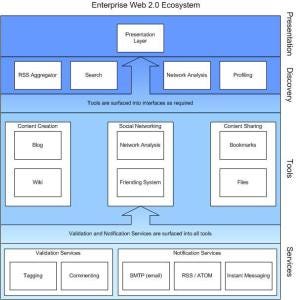Model of Web2.0 for the Enterprise
This is something that’s been consuming my thinking recently. I believe quite strongly that tools like Wikis, Blogs, Social Networks and others clearly represent real value for the enterprise. But I also believe that there is a gap at the moment, the tools haven’t crossed the divide from the consumer world to the Enterprise (see my earlier post on this http://binaryplex.com/2007/05/27/what-start-ups-should-know-about-enterprises/).I think there is a lot of evidence this is beginning to change, you only need to look at both IBM and Microsoft to see that features and tools that have evolved on the Internet are beginning to eek their way slowly into their product sets. In some cases, there are partnerships to short-circuit their gaps, in others the big boys are starting again from scratch.All of this has had me thinking about what does a model of the Web2.0 look like within the Enterprise. Not what is the tool and who wrote it, but if you could design a system supported by standards (some of which exist), what is enterprise ready today, and where are the gaps.I present my first cut of my model of Web 2.0 for the Enterprise. I’ll take some time over the next week to post further and explain the concepts on here. I’d love to take your feedback — I think a proper “joined up” design is what we need to work out where the gaps really are and how Enterprises want to use them. One simple example of the kind of joined up thinking required (not on the model funnily enough) is security — inside the enterprise I don’t want 15 different security models, or to log in repeatedly as I move between my blog and my wiki.

As I see it, the model is laid out in four parts, from bottom up:
- Services — fundamental elements that provide consistent experiences and management throughout the stack. These are broken down into:
- Notification Services
- Validation Services
- Tools — the components that a pull together into a solution, they may exist discretely or combined together. These are broken down into:
- Content Creation
- Social Networking
- Content Sharing
- Discovery — the “glue” that pulls it together, and often missed in the Enterprise today (how many of you have blogs without a service like Technorati to surface content and find blogs from feeds. This is where I believe the emerging smarts are only now really starting to mature with tools like Particls, Spock and others to name a few I’ve mentioned.
- Presentation Layer — the UI layer. Critical for the consisten experience that the enterprise expects.
So there it is, as I say, feedback and comments welcome and appreciated — I going to expand further on this and explain the reasoning and functions behind each component in more detail, and look at what tools exist today that fill some of these gaps.
